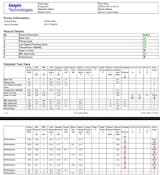The high-pressure is an important part of the diesel engine high-pressure common rail electronic control system. How to repair the high-pressure common rail injector when it fails?
Solenoid valve maintenance
- External circuit inspection: use the resistance file of a multimeter to measure the resistance between the solenoid valve of each injector and the corresponding terminal of the ECU to determine whether there is a short circuit or open circuit fault in the external circuit;
- Solenoid valve resistance measurement: turn off the ignition switch and unplug the injector solenoid valve plug, the resistance value of each solenoid valve is about 0.2~0.4Ω;
- Solenoid valve current check: the peak current of the injector is about 18A during operation, and the holding current is about 12A;
- Check the operating voltage of the solenoid valve: After starting, there should be a 5V pulse voltage input at the solenoid valve terminal of the injector.
Injector gasket adjustment method
- Valve spring adjustment gasket: adjust the size of the solenoid valve spring force, each injector valve spring force setting value is definitely different, too large or too small will affect the size of the fuel injection in the corresponding area, generally the maximum allowable tolerance ±3N.m;
- Armature lift adjustment gasket: if the armature lift is too large or too small, it will directly cause the injector to not spray or the injection is too small. This part of the gasket will only affect the size of the pre-injection volume point and will not affect others Point injection, so the maximum tolerance is ±5 microns;
- Nozzle spring adjustment gasket: adjust the size of the nozzle spring force (abbreviated as nozzle needle valve opening pressure), the maximum tolerance is ±3N. The excessive spring force will cause the fuel injection to deteriorate, especially the idling stage will affect the idling speed Black smoke
- Buffer lift adjustment gasket: Generally, the maximum tolerance is ±20 microns. The buffer lift gasket should not be too thick, otherwise, it will cause a large amount of oil return from the injector. Its thickness will not affect the fuel injection volume of a single measurement point. It will affect the total amount of multiple injections in a short time;
- Needle valve lift adjustment gasket (middle piece): adjust the maximum displacement of the nozzle needle valve during operation. The setting value varies with different injector models, generally ranging from 200 microns to 350 microns, and the maximum tolerance is ±10 microns. This part mainly affects the fuel injection volume at the full load point;
Other maintenance experience:
- In the fuel injector oil pump bench test, all test points are within the tolerance range except for the large oil return;
Reason: It may be that the valve seat surface is worn and the oil return becomes larger. Replace the valve;
- Reasons for continuous fuel injection:
(1) There are particles blocking the oil return hole of the valve seat;
(2) There are particles stuck on the seat surface of the nozzle;
(3) It is also possible that the valve stem cannot be seated and the oil inlet hole is sealed;
Precautions
• Pay attention to cleanliness during the maintenance process of the fuel injector. Blow it before assembling, if it seems redundant, it is necessary.




